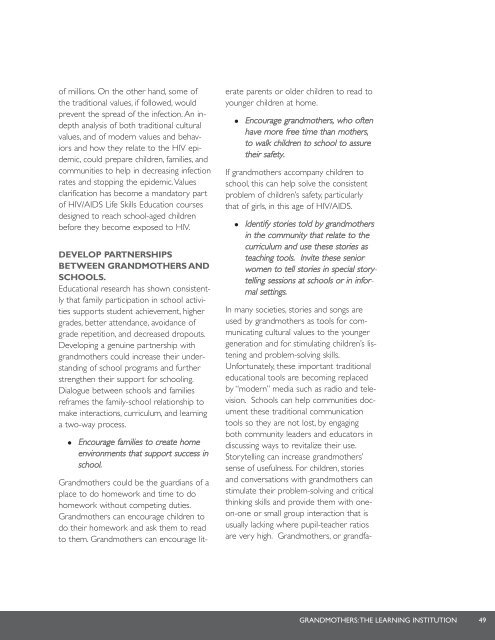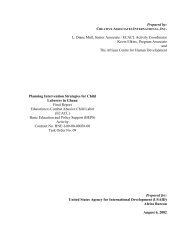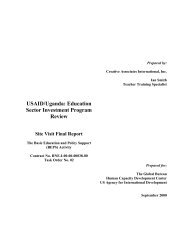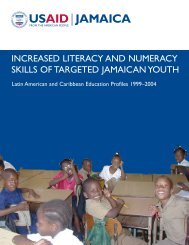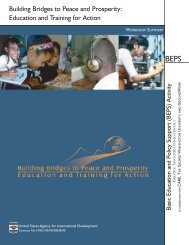Grandmothers: A Learning Institution - Basic Education and Policy ...
Grandmothers: A Learning Institution - Basic Education and Policy ...
Grandmothers: A Learning Institution - Basic Education and Policy ...
- No tags were found...
Create successful ePaper yourself
Turn your PDF publications into a flip-book with our unique Google optimized e-Paper software.
of millions. On the other h<strong>and</strong>, some ofthe traditional values, if followed, wouldprevent the spread of the infection. An indepthanalysis of both traditional culturalvalues, <strong>and</strong> of modern values <strong>and</strong> behaviors<strong>and</strong> how they relate to the HIV epidemic,could prepare children, families, <strong>and</strong>communities to help in decreasing infectionrates <strong>and</strong> stopping the epidemic.Valuesclarification has become a m<strong>and</strong>atory partof HIV/AIDS Life Skills <strong>Education</strong> coursesdesigned to reach school-aged childrenbefore they become exposed to HIV.DEVELOP PARTNERSHIPSBETWEEN GRANDMOTHERS ANDSCHOOLS.<strong>Education</strong>al research has shown consistentlythat family participation in school activitiessupports student achievement, highergrades, better attendance, avoidance ofgrade repetition, <strong>and</strong> decreased dropouts.Developing a genuine partnership withgr<strong>and</strong>mothers could increase their underst<strong>and</strong>ingof school programs <strong>and</strong> furtherstrengthen their support for schooling.Dialogue between schools <strong>and</strong> familiesreframes the family-school relationship tomake interactions, curriculum, <strong>and</strong> learninga two-way process.• Encourage families to create homeenvironments that support success inschool.<strong>Gr<strong>and</strong>mothers</strong> could be the guardians of aplace to do homework <strong>and</strong> time to dohomework without competing duties.<strong>Gr<strong>and</strong>mothers</strong> can encourage children todo their homework <strong>and</strong> ask them to readto them. <strong>Gr<strong>and</strong>mothers</strong> can encourage literateparents or older children to read toyounger children at home.• Encourage gr<strong>and</strong>mothers, who oftenhave more free time than mothers,to walk children to school to assuretheir safety.If gr<strong>and</strong>mothers accompany children toschool, this can help solve the consistentproblem of children’s safety, particularlythat of girls, in this age of HIV/AIDS.• Identify stories told by gr<strong>and</strong>mothersin the community that relate to thecurriculum <strong>and</strong> use these stories asteaching tools. Invite these seniorwomen to tell stories in special storytellingsessions at schools or in informalsettings.In many societies, stories <strong>and</strong> songs areused by gr<strong>and</strong>mothers as tools for communicatingcultural values to the youngergeneration <strong>and</strong> for stimulating children’s listening<strong>and</strong> problem-solving skills.Unfortunately, these important traditionaleducational tools are becoming replacedby “modern” media such as radio <strong>and</strong> television.Schools can help communities documentthese traditional communicationtools so they are not lost, by engagingboth community leaders <strong>and</strong> educators indiscussing ways to revitalize their use.Storytelling can increase gr<strong>and</strong>mothers’sense of usefulness. For children, stories<strong>and</strong> conversations with gr<strong>and</strong>mothers canstimulate their problem-solving <strong>and</strong> criticalthinking skills <strong>and</strong> provide them with oneon-oneor small group interaction that isusually lacking where pupil-teacher ratiosare very high. <strong>Gr<strong>and</strong>mothers</strong>, or gr<strong>and</strong>faGRANDMOTHERS:THE LEARNING INSTITUTION49


